I’ve got pomegranate trees that produce reliably, but I know others who don’t and I want to help them. So this spring I’m learning more about pomegranate flowers and tree fruitfulness. Join me.
Pomegranate flowers, from start to finish
This week, on one of my trees I found flowers in every stage, from newly emerging to developing into fruit, and I photographed the stages.
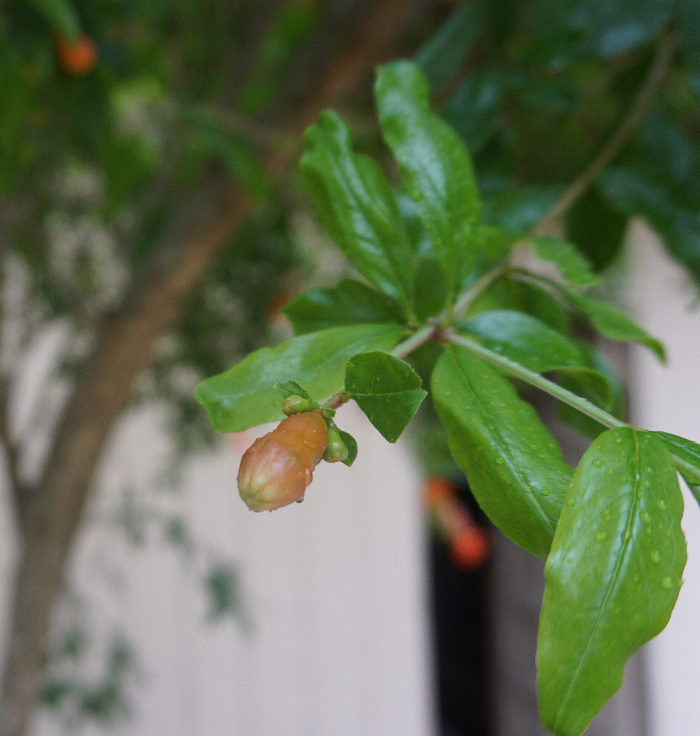
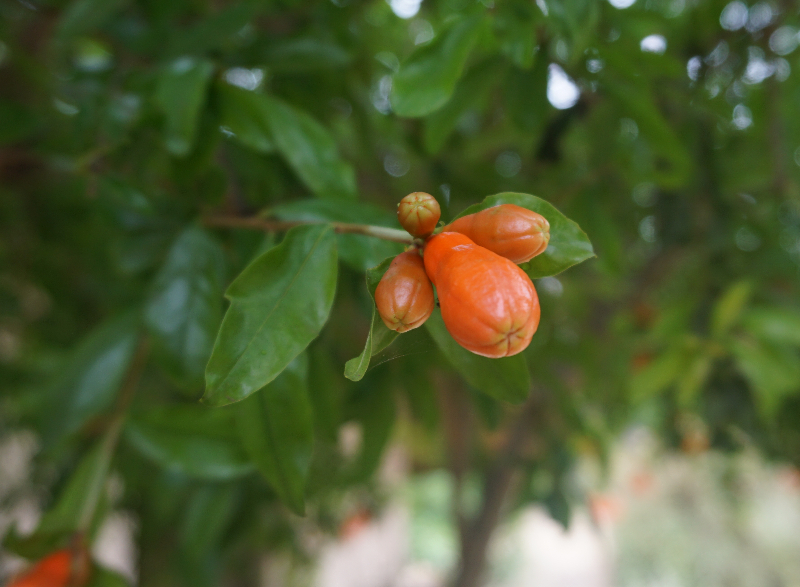
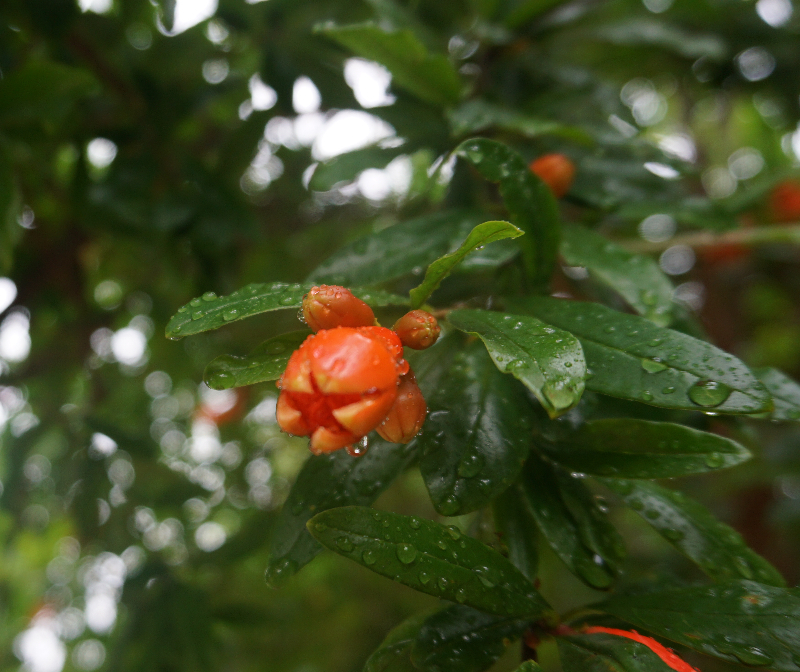
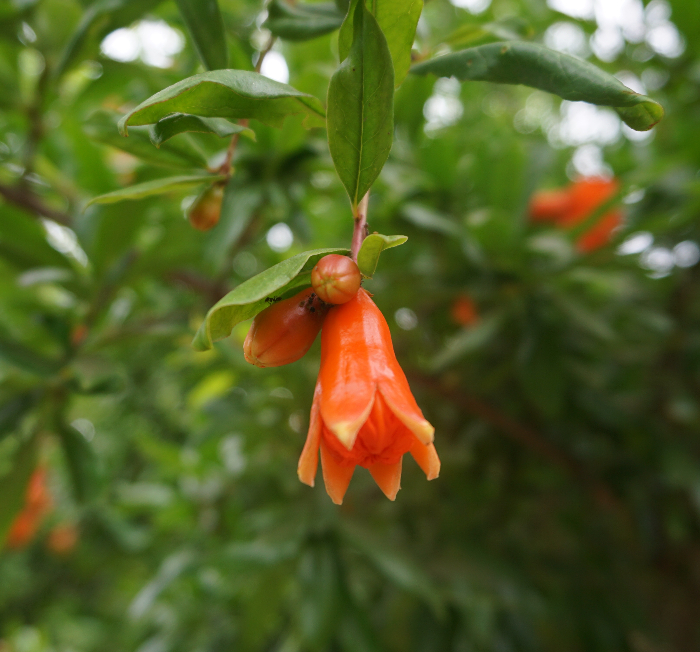
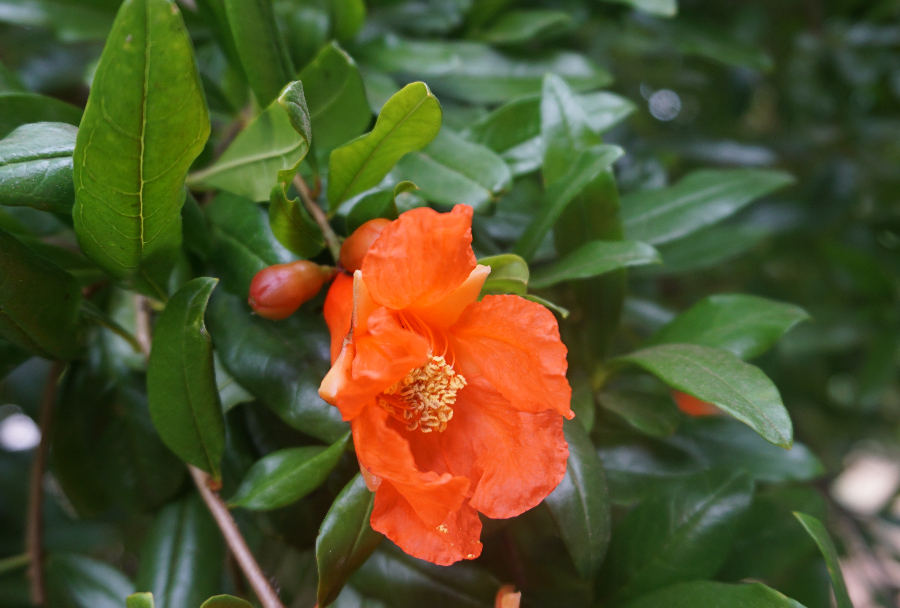
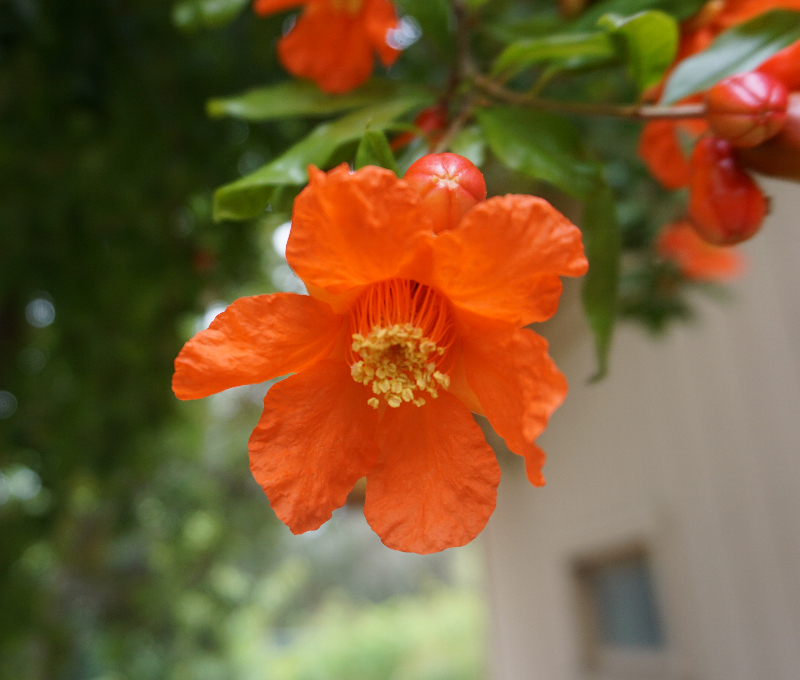
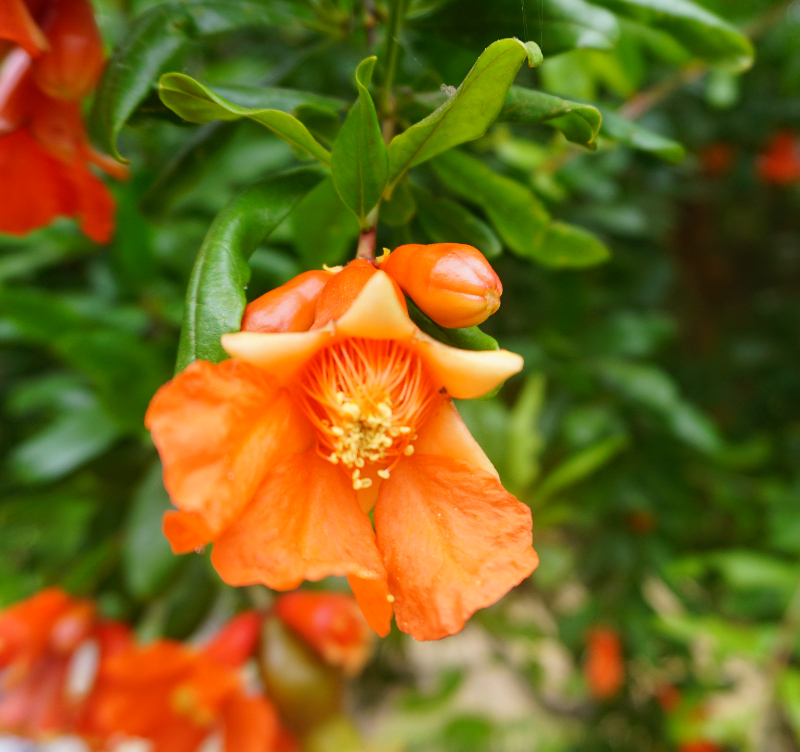
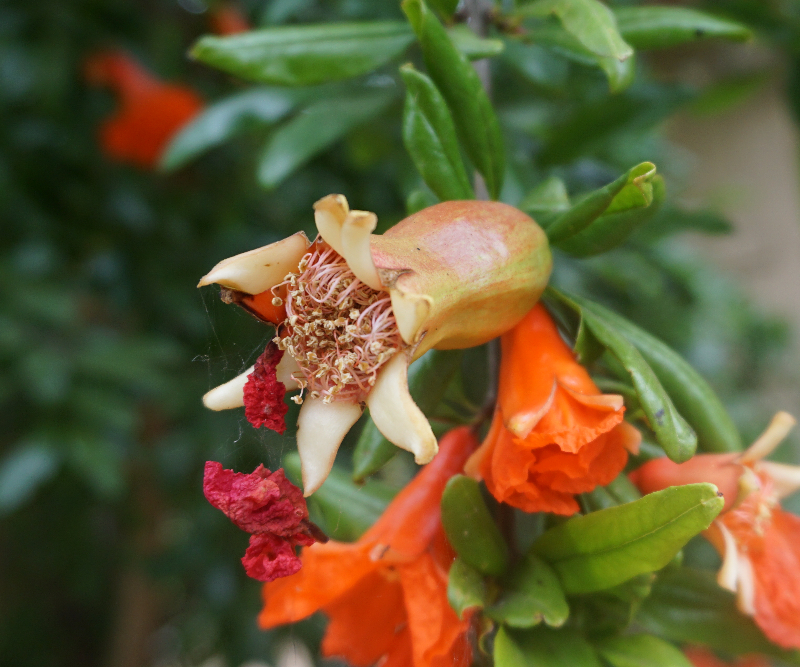
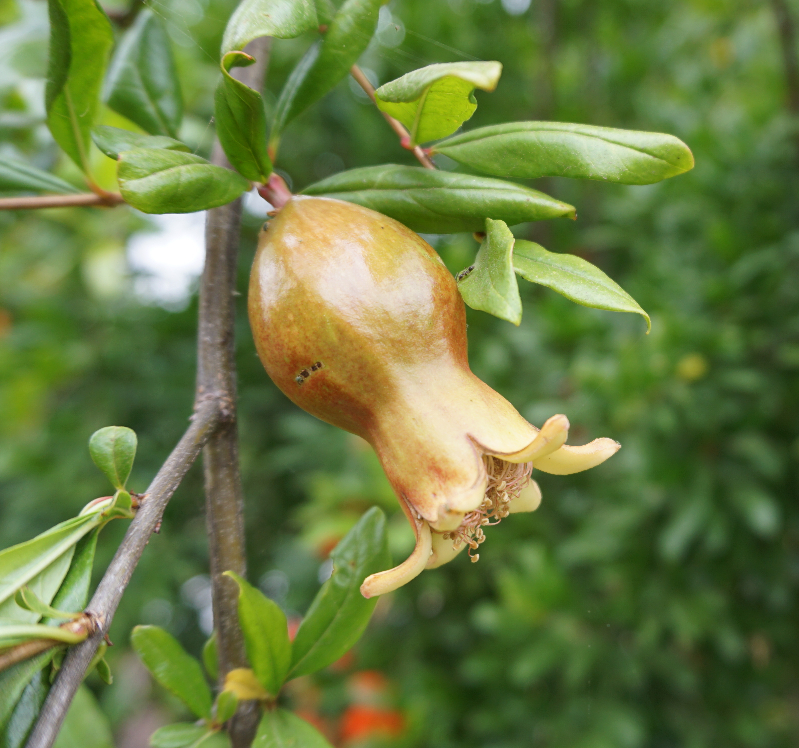
Pomegranate flowers, location, fruit production and pruning
While taking the pictures I noticed where the flowers were growing. They were not growing on the interior of the tree, nor were they growing out of larger, older branches.
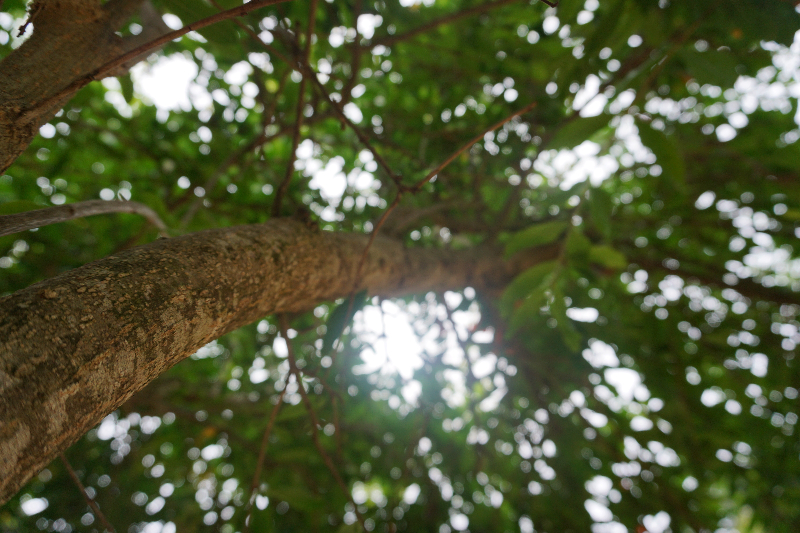
They were growing at or near the tips of small, young branches.

This made me think about pruning. If in the winter you pruned a pomegranate tree like a hedge, shearing off the sides or top, you would be cutting off the places where flowers would form. You would be greatly reducing the flowers and therefore fruit potential of the tree.
Pomegranate trees grow so well in my part of inland Southern California that some neighbors use them to line their property as a privacy screen from the road. Each winter, they hedge them back so they don’t encroach on the road. Here is what one of these pomegranate hedges looks like today.
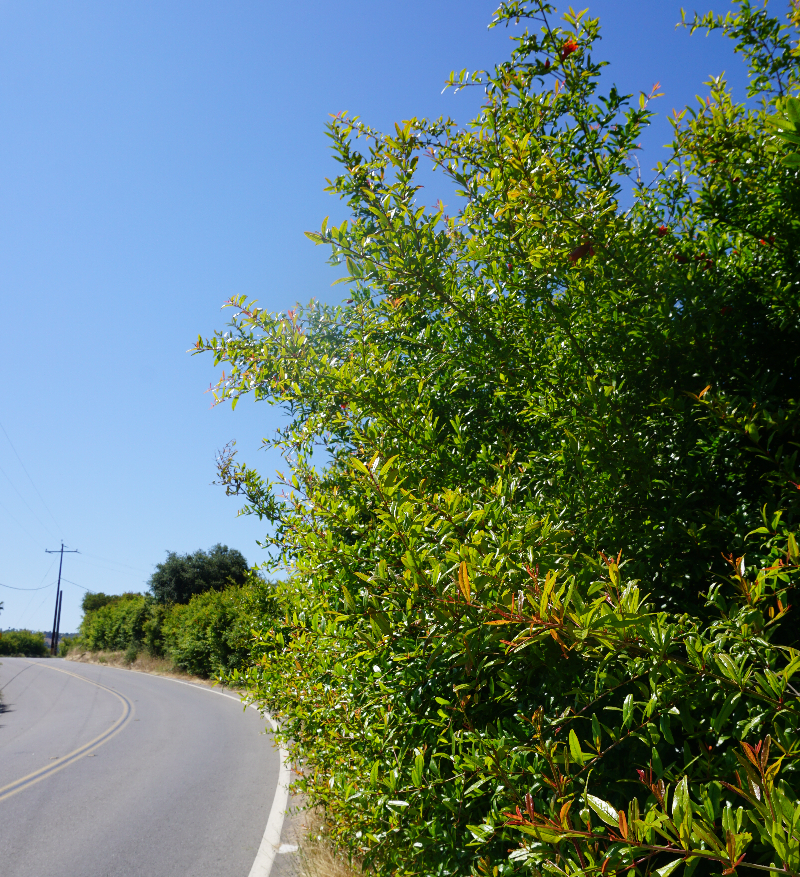
Where are the flowers? There are almost none because of the hedge pruning.
If you have a pomegranate tree that makes little fruit, make sure it’s not because you are cutting off the ends of its branches during your winter pruning.
If you need to prune your pomegranate tree in order to keep its size down, use thinning cuts mostly. Thinning cuts are where you remove entire branches back to where they grow from a larger branch. This way you retain the ends of many branches. (See a 30-second video where I make a thinning cut on a pluot tree here.)
Pomegranate flowers, male or female or?
A friend told me some years back that some flowers on a pomegranate tree are male while others are female. I believed her because I knew how smart and experienced she was with other fruit trees, but when I looked at pomegranate flowers I could never see any difference.
This week I started reading scholarly articles and cutting into the organs of flowers to discover the truth about this. I’ve concluded that it’s kind of true, but not really.
Every flower that I cut into had all of the male and female parts.
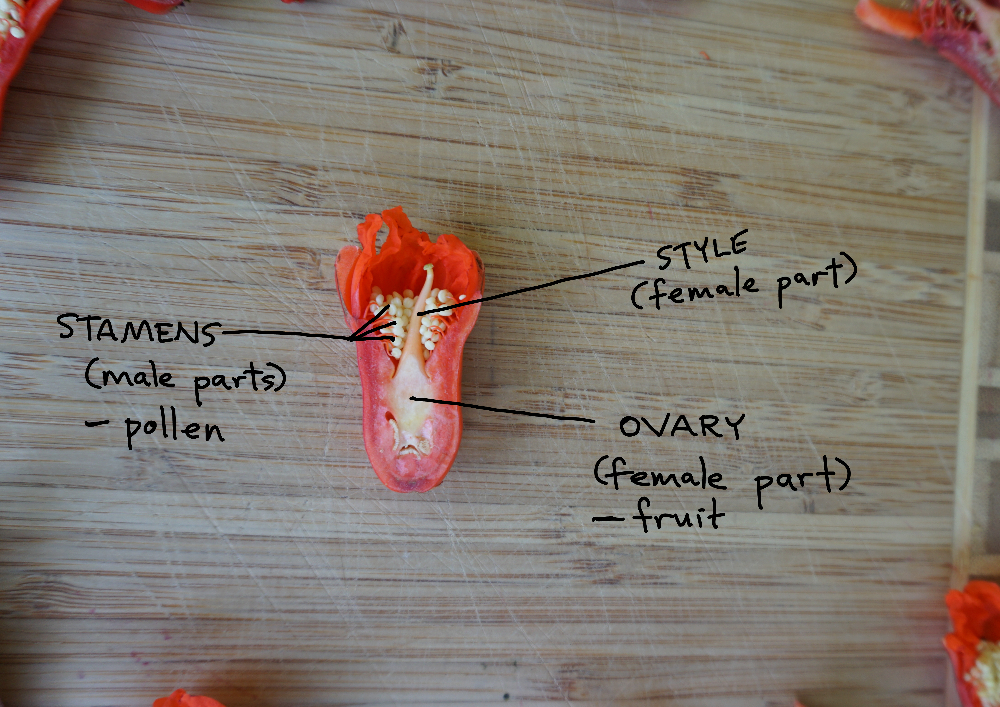
However, there was a gradient in how big the female parts were.

Because of this, some people call the flowers with the biggest female parts “female” and those with the smallest female parts “male.” Here is a discussion on pomegranate flower terminology where the authors choose to categorize the flowers as either “bisexual” (rather than female) or “male.”
But what about flowers with medium-sized female parts? Other researchers put the flowers into three classes: “male,” “hermaphrodite” (female/bisexual), and “intermediate.” Here is how some flowers I cut open would be classified in those three ways:
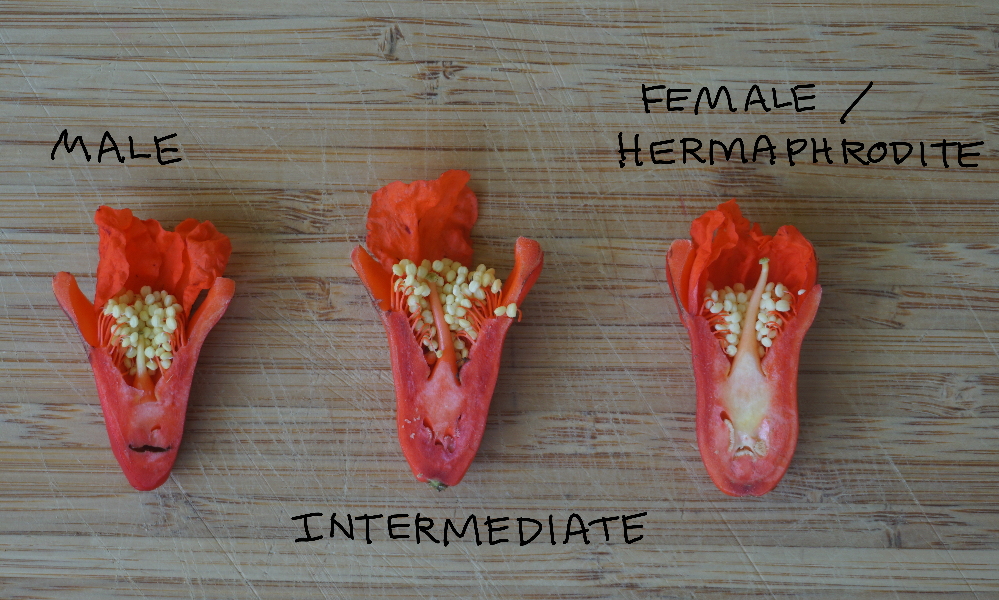
Although the terminology debate is pedantic and of no practical importance, what I have found is that the flowers that a tree sheds would usually fall into the male and intermediate classes whereas the flowers that the tree holds and develops into fruit would be called hermaphrodite (or bisexual/female). Here are examples.
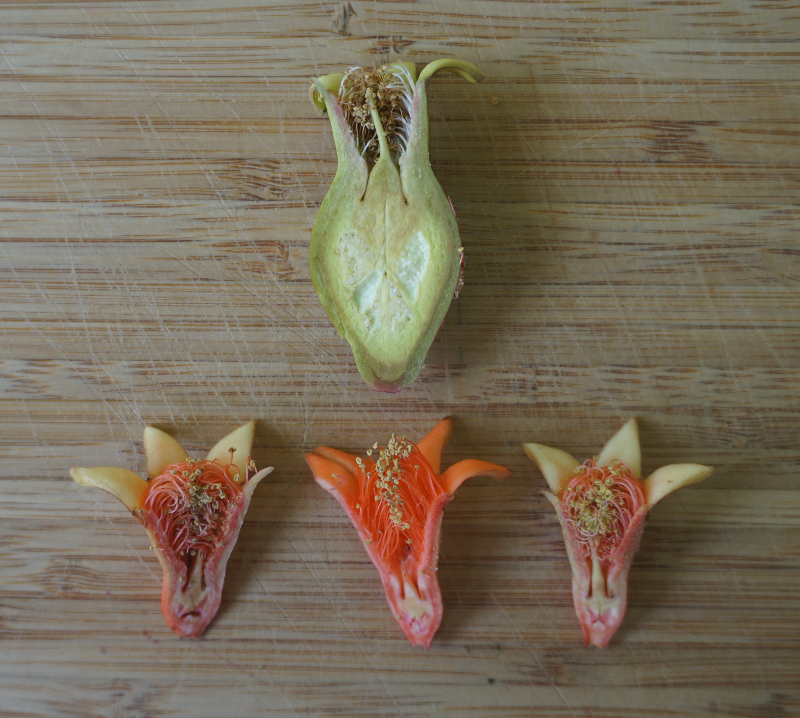
And what I have observed after picking flowers from trees of different varieties is that some trees have more hermaphrodite flowers. This implies that such varieties have more fruiting potential. And here is a study of many pomegranate varieties that finds the same.
Lesson: Is your pomegranate tree not making much fruit? Perhaps it is a variety that has relatively few hermaphrodite flowers. Perhaps you’d get more fruit with a variety that makes more hermaphrodite flowers.
Which varieties are those? There are lists. (Find one in the study linked above.) But I wouldn’t bother trying to find a list. Rather, I would find a productive pomegranate tree in your area whose fruit you like and buy that variety (if you can learn the name), or grow a cutting from that individual tree. Growing pomegranates from cuttings is as easy as growing grapes from cuttings.
There are lots of reasons that fruit trees don’t make much fruit. And here we have insight into two reasons that pomegranate trees might not make much fruit: pruning off branch tips, and varieties that make few hermaphrodite flowers.
All of my Yard Posts are listed HERE
Thanks to the Supporters, my website has no ads disrupting your reading experience or influencing its content. Learn how you can support my Yard Posts HERE

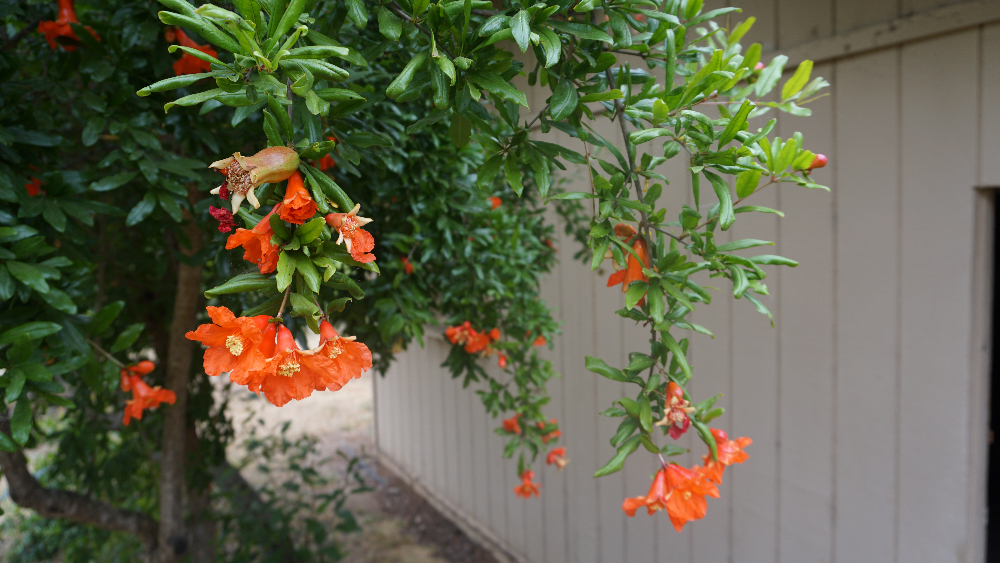


Very interesting layperson research. Gorgeous flowers!
Very helpful. I’ve been haphazard with pruning, mostly when it strikes me. I end up with bumper years and others very sad. I have a feeling it has more to do with my timing of the chop.
Our tree is in the lower part of canyon backyard and gets no supplemental water. What other fruit tree can you say that about?
I wonder how much tree age factors into any of this. We inherited our tree from the previous owner, and I suspect it is quite old (60+ years). The fruit is still delicious and of better quality than you get in store.
My curiosity is, if you have the space, should you prune at all if production is your only consideration?
I’m still putting frozen arils from last year in smoothies lol.
I’m with you, Brandon Sproat — I care about having a good harvest, eating the fruit, and enjoying the shade… 😉
Pomegranate only fruits on 2-3 year old wood, right? Mine took so long that I almost ripped it out, so I can believe it 😆
Hi Brandon,
So true. I don’t water my old pomegranate either. I love pomegranates for their suitability to this climate.
I know of some in the neighborhood that I’ve never seen get pruned and they produce loads of fruit. I’m not sure about this, but I can’t imagine how pruning a pomegranate would help it produce more fruit. I only prune mine for size and shape needs.
I have a pomegranate tree that produces well occasionally. Propagating a pomegranate tree from cuttings is valuable info so I assume one could also dig up a sucker (of which I have many!) and also root those to a productive tree?
Hi Axel,
I don’t know about that. Although I always see pomegranate trees sending up growth at the base of their trunk, I haven’t seen them send up root suckers. But I would guess that if that happened, you could dig it out carefully and transplant it.
Hi, Greg, I have a question, I just got my first Parfianka pomegranate tree, and I was wondering, how many times a week should I water it?
Hi Idalia,
I love the Parfianka variety. Check out this post for guidance on watering your tree: https://gregalder.com/yardposts/how-much-to-water-a-fruit-tree-in-southern-california-roughly/
Such a timely article! I pruned my mega-producer of a pomegranate last fall for the first time, so I have very few flowers this year. I have a ton of seedlings this year. Has anyone had any experience with the productivity of volunteer pomegranates?
Hi Tanya,
Not much experience with that, but I do have one seedling that’s been growing for a couple years and hasn’t flowered yet.
I’ve got two, each about two years old. The one in full sun is flowering. The one that gets about 4 hours of sun is not flowering although it seems to be growing fine.
I’m about 5 miles from the coast in San Diego. Any idea how dependent flowering is on sun exposure? I’m considering moving the nonflowering one in the winter, if needs be.
Hi Matt,
In my limited experience with pomegranates it does seem to make a difference. Every other type of fruit tree I know of makes more flowers in more sun and I have no reason to think pomegranates work differently. I’ve got a large tree that gets lots of sun and a small tree that is in half shade, and the large tree flowers and fruits a lot more than the small one. BUT, they are different varieties and there could be many other factors influencing these results. If you have a sunny spot for the non-flowering pomegranate, I would move it.
It’s almost June and i don’t see any flowers I’m worried when do they bloom?
Feel for the pistil!
Here’s a portion of an article I wrote for the Fruit Gardener:
Bright red-orange flowers are a noticeable feature of pomegranate trees in early spring. A close look tells you there’s something peculiar about them; there are two distinct kinds. Some of the flowers are perfect, meaning they have both male and female parts. These are the ones that can make fruits. The other kind of flower is male. Botanists call a plant that produces both male flowers and perfect flowers andromonoecious.
But how can a close look tell you this? Male flowers have a different shape. The male flowers come to a relatively sharp point where they attach to a branch, while the perfect flowers have more rounded bases. Vase-shaped or bell-shaped, some call them. Both kinds of flower have many stamens. With all that pollen around, it’s understandable that the perfect flowers rarely go unpollinated.
The stamens hide another female feature of the perfect flowers, the pistil. The pistil is hard to see but often easily detected by feel. A finger pressed into the top of the flower can usually feel the pistil that comes up in the center of a perfect flower, although not always. But I’ve never felt a pistil on a male flower.
It’s good for growers to know about andromonoecy, because pomegranates produce more male flowers than perfect flowers. The male flowers always fall off. Sometimes young trees produce only male flowers, and amateur growers can get discouraged when they all fall off.
Thanks, Don. I appreciate the tip on feeling for the pistil because the vase/bell shape indicator is often too subtle for me to detect (although some varieties are more obvious than others). I have one variety where the tip of the pistil (stigma) is never visible even on female/perfect/hermaphrodite flowers; it’s always covered by stamen (anthers) so now I will feel instead of look!
Don, I tested this out and it was easy for me to feel the pistils even when I couldn’t see them from the outside.
This is really good to know – that young trees can produce mostly male flowers. I went big on pomegranates and planted 8 around three years ago. They flower but I have never gotten a fruit yet. I figured I probably wouldn’t until the trees were at least 5 years old. I am growing mostly Gregory Levin varieties: Parfianka, Arianna, Desertnii. I also have a Wonderful & Granada.
Also why are some of the female fruit flowers falling off my tree? They are growing into fruit and then are on the ground.
I checked all of my Pom bushes today for female flowers and found a few fruits developing. One of my Parfiankas has a few fruits and so does the Ambrosia. Thank you Donald Winterstein for the tip about feeling for the pistils! I have learned so much from this article and the comments.
How can you get more female producing fruit? Should we pick off the male ones?
We have a 6-7 year old wonderful variety pomegranate. We have good yield but when we cut into the pomegranate a burgundy red color the arils are pale pink or translucent. last year we waited till December to pink and at that time they were rotting on the inside. We would like any advice anyone may have to help us grow decent edible pomegranates.
Those sound like the hybrid white pomegranate. Researc those. The arils can be from almost white to pale yellow. I have a hybrid pom. The arils look like popcorn. They are sweeter, less tart and wonderful to eat. They are extremely edible and delicious.
Thanks Steve for the heads up. Sounds interesting will look into hybrids.
Hi Ajey,
I know that Wonderful arils get deep red, and I know that when I pick similar varieties early the arils are less red (pale pink/translucent). But I don’t know why yours would start rotting once they reach full color.
The only thing I can think of trying is cutting off the water at the end of summer.
Pomegranates flower from 2nd year growth. This growth will continue to fruit for several years, then stop and newer growth will fruit it’s the 1st and 2nd year growth that’s important to not prune.
I’ve read this over and over again from articles written my commercial pom growers..
Hi Greg: what is the reason the flowers fall off before the fruit forms?
tom mcdougall
Hi Tom,
I’d guess there could be multiple reasons, but one is that the flowers don’t have fully developed female parts such that they are incapable of forming a fruit. (See such flowers in the photos above.)
If you see many fallen flowers below your pomegranate tree, I would cut them open to see how long the styles are and how fat the ovaries are. Would they be classified as “male” as described above? If so, then they can’t be expected to form fruit and hold on the tree. They are useful as pollen sources, but then the tree just sheds them since they can’t become fruit.
Last year I only got a handful of pomegranates off my 3 trees all under 6 years old.
This winter did what hopefully would be considered “thinning” and our trees are full of blossoms now (many dropping along the way) so fingers crossed this will translate to abundance in the fall.
I love this, thank you. We have a pomegranate tree in our back yard which gets a moderate amount of sun. We have a small backyard so we do have to prune it pretty frequently to keep it’s shape. It’s about 3 years old and it’s never produced. I hope it’s because of me pruning it too much and not because it’s a male. This article did reassure me if I understand it correctly. I love the shade it provides and if it only produces a few fruits it’s ok, but as long as it produces.
Going to water it more, prune during the winter, prune back branches if I have to to keep it’s shape.
I have 3 plants of Dwarf Pomegranate “Nana” about 60 cm tall, that I planted from seeds 2,5 years ago. They are grown outdoors here in southern Sweden in full sun in summer, but now in cold season I keep them indoors. They didn´t start to flower until very late end of September and are still flowering now end of October, they have had hundreds of flowers but all flowers are “males” that falls off after a while!? What is the reason for this? Are they still too young or is it because they flower too late in the season? I pollinate every flower with a soft brush by hand, but I have never seen or felt any pistil!
Hi Jan,
As far as my experience goes, pomegranates grown from seed do not come true, meaning they become a tree that is somewhat different from the parent tree. Since you grew these trees from Nana seed, maybe they can’t be expected to fruit like the Nana variety. I know that some varieties of pomegranate make flowers but little or no fruit.
The flowering at the end of September is extremely late, but maybe that is partly due to your climate in Sweden. Or maybe the trees will flower earlier as they age.
If you do want a pomegranate that is sure to fruit, you can grow one from a cutting (if you can get your hands on a cutting) of a variety whose fruit you know and like. I have propagated all of my pomegranate trees from cuttings in the same way I do for grapes: https://gregalder.com/yardposts/propagating-grapes/
Hi Greg, nice article. I have a question about pruning. The new flush in spring – I prune the tip of the flush shoot leaving 2-3 new side branches as otherwise the branches become too big and lanky. Is that something I should not do to get more flowers? The problem is the branches otherwise become too long…I am struggling to keep the tree (Wonderful) away from the other fruit trees around.
My pomegranate trees are bursting with flowers! I think after your post last summer I did dissect a few blossoms. I guess the question is “do we thin them?” I love pomegranates and eat all of them!